Electrochemical Behaviour of Dopamine on A Glassy Carbon Electrode Modified by Graphene Chitosan Copper Composite
Renjini S1, Jyothish kumar T2, Sreevalsan K2 and Anitha Kumary V1
1Department of Chemistry Sree Narayana College for Women Kollam.
2Department of Chemistry Sree Narayana College Kollam.
Corresponding Author: anithasreevalsan@gmail.com
DOI : http://dx.doi.org/10.13005/ojc/330325
Graphene is a hexagonal honeycombed network of carbon atoms arranged in a single layer which is the fundamental building block of all graphitic materials. The novel properties associated with graphene offer many advantages for electrochemical applications. The present work aims at preparing graphene copper chitosan composite for the voltametric determination of the most prominent catechol amine dopamine. Modified Hummers method was followed for Graphite oxide (GO) preparation. GO and CuSO4.5H2O were brought into an aqueous solution, to this chitosan was added which was refluxed and subsequently reduced to obtain the required graphene –copper composite. The composite was characterized structurally and morphologically by XRD, SEM and it was used for modifying a glassy carbon electrode. The modified electrode was used for sensing dopamine by CV and DPV. The effect of scan rate and pH on the performance of modified glassy carbon electrode was evaluated. The fabricated electrode was also evaluated for the simultaneous determination of dopamine and uric acid. This electrochemical sensor was found to be most sensitive and reliable at the physiological pH 7.
KEYWORDS:Graphene-Copper composite; electrochemical sensor; Dopamine
Download this article as:| Copy the following to cite this article: Renjini S, kumar J. T, Sreevalsan K, Kumary A. V. Electrochemical Behaviour of Dopamine on A Glassy Carbon Electrode Modified by Graphene Chitosan Copper Composite. Orient J Chem 2017;33(3). |
| Copy the following to cite this URL: Renjini S, kumar J. T, Sreevalsan K, Kumary A. V. Electrochemical Behaviour of Dopamine on A Glassy Carbon Electrode Modified by Graphene Chitosan Copper Composite. Orient J Chem 2017;33(3). Available from: http://www.orientjchem.org/?p=33018 |
Introduction
Dopamine (DA) plays an important role in human body as a neurotransmitter in the central nervous system1. The biochemistry of DA points to the facts that several diseases such as Schizophrenia, Parkinsonism and Huntington11 are caused by abnormal levels of DA2. Levels of Uric acid (UA) which is the primary metabolic product of human body is in milli molar and micro molar levels in urine and serum respectively3. Monitoring the levels of these compounds is has been the target of many researchers. The studies on the electrochemistry of DA are helping us to understand its physiological functions and action mechanism in human body4. Different methods like capillary electrophoresis, chromatography, fluorometry, chemiluminescence etc. are available for the detection of these molecules. But electro analytical techniques are more acceptable due to low cost, fast response, portable nature and easy fabrication of the sensor for the detection of these electro active species. The most challenging problem in the detection arises mainly due to overlapping of voltammetric signals at many of the solid electrodes and that can be addressed by modifying the working electrode for obtaining well resolved signals. Many modifiers such as polymers, metal oxides and metal complexes have been effectively used together with carbon based materials5-9. Graphene a single layer of hexagonal close packed honey comb crystal lattice is being extensively used in various fields such as electronics, optical, magnetic, biological, medicine, energy storage, catalysis etc. Graphene is being widely used in sensor applications due to its exceptional properties such as theoretical specific surface area, high values of Young’s modulus, excellent thermal conductivity and amazing intrinsic mobility10. Chitosan (CHI) is an amino-polysaccharide. The novel CHI-metal based materials find many applications in the fields of environmental science and technology, catalysis, medicine and engineering for the development of biosensors. For many years, Cu and Cu-based electrodes have been used extensively as anodes in electroxidation of organic compounds11-15. In the present work we aim at preparing Graphene Chitosan–Copper (GN-Cu) composite and using it for the voltammetric determination of dopamine (DA).
Experimental
Materials and Methods
Analytical grade chemicals were used for the present study. Chemicals used for this work were graphite powder, potasium permanganate powder, conc. sulphuric acid, conc.phosphoric acid, 30%H2O2, HCl, CuSO4.5H2O, Acetic acid, Ascorbic acid ,Sodium hydroxide, Hydrazine, Chitosan methanol, etc. All the prepared samples were analyzed by PXRD, SEM, Cyclic voltammetry (CV) and differential pulse voltammograms (DPVs) were recorded using CHI 604D electrochemical analyzer, in a conventional three-electrode cell. A platinum wire served as the counter electrode. The reference electrode was Ag/AgCl .The glassy carbon electrode (GCE) modified with the composite as working electrode. The study was conducted at room temperature.
Synthesis of Graphene – Copper Composite
Modified Hummers method was followed for Graphite oxide (GO) preparation 16. An aqueous solution of CuSO4·5H2O and graphite oxide (GO) was made by dissolving in double distilled water. This solution was added drop wise to a solution of chitosan. Reflux with stirring for 20 minutes at 120 °C an added 0.05 M ascorbic acid. Then 0.6 M NaOH solution was added with stirring. Stir for another 30 minutes and then added N2H4 and continue stirring for 30 min more for completion of the reaction and mixture is allowed to cool to room temperature. The solution was centrifuged and washed to obtain pure grapheme (GN) Cu-NPs
Fabrication of Working Electrode
Alumina slurry was used to polish the bare GCE followed by ultrasonication . The dispersion of the composite in methanol was prepared and sonicated for two hours, and 6µl of the composite suspension was drop casted on the surface of GCE and dried in air.
Results and Discussion
Characterization
Fig 1A shows the XRD of GO, the 2θ peak at 11.7º corresponds to an interlayer distance of 7.6 Å. The XRD of (Fig 1B) GN-Cu nano composite does not have a peak around 100 indicating successful reduction of GO16. Composite shows characteristic diffraction peaks at 43.01,50.15 and 73.8 representing the (111) ,(200), and (220) crystalline planes of copper respectively17. XRD pattern showed that the composites prepared by chemical reduction method posses cubic face centered structure. Purity of the sample is evident from the absensence of other noticeable peaks in th pattern for CuO and Cu2O.. Particle size of as prepared composites by this method was found to be 23.4 nm
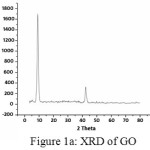 |
Figure 1a: XRD of GO |
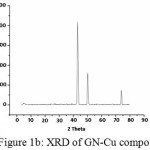 |
Figure 1b: XRD of GN-Cu composite
|
The SEM images (Fig 2) also reveals that the Cu particles are distributed on graphene sheets.
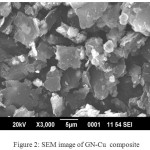 |
Figure 2: SEM image of GN-Cu composite Click here to View figure |
Electrochemical Response of DA at Modified Electrode
The detection of dopamine (DA) was performed using cyclic voltammetry and differential pulse voltammetric methods. The electro oxidation of DA was first examined in bare and modified GCE by cyclic voltammetry in phosphate buffer at pH 7 (fig 3). At the bare GCE an irreversible oxidation peak appeared at 0.404 V. In the modified electrode the peak potential is reduced by 150mV by appearing a reversible peak at 0.254V and peak current is also enhanced compared with the bare electrode. This improvement can be attributed to the edge planes of graphene 18. The peak at -0.018V is the oxidation peak of copper and it is assigned to Cu/Cu (II) transitions19,20.
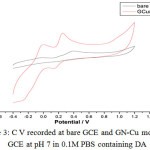 |
Figure 3: C V recorded at bare GCE and GN-Cu modified GCE at pH 7 in 0.1M PBS containing DA
|
Optimization of Parameters
Influence of Ph
The influence of solution pH on the electrochemical response was investigated in phosphate buffer solution. The variation of peak current with respect solution pH in the range 3 to 9 was observed ( Fig.4).
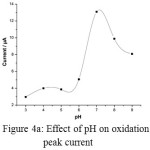 |
Figure 4a: Effect of pH on oxidation peak current Click here to View figure |
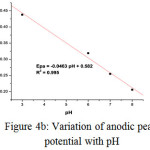 |
Figure 4b: Variation of anodic peak potential with pH Click here to View figure |
Results show that solution pH varies linearly in the range of 3 to 9 with a linear equation of Ep = 0.58 – 0.046 pH, r = 0.995, .This points to the fact that DA redox reaction is a two electron two protons process as already reported 21,22. Oxidation peak current increases with pH and reaches a maximum at pH 7, then decreases as the pH continues to increase. Therefore the pH at this study is optimized as 7.
Effect of Scan Rate
Cyclic voltammogram of DA at pH7 on GN-Cu/GCE was recorded at different scan rates (v).The scan rate varied as 10-1000 mV/s are shown in fig.5. There is a linear relation between the oxidation peak currents and scan rate in low scan rate with correlation coefficient of 0.997 for DA (fig.6A), indicating adsorption controlled process. A similar linear relation was also observed between oxidation peak currents and scan rate in the high scan rate up to 1000mV/s (fig.6B) with correlations of 0.995 indicating it is also adsorption controlled mass transfer. Hence it is an adsorption controlled process both in low and high scan rate23,24.
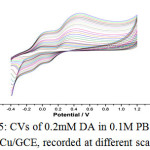 |
Figure 5: CVs of 0.2mM DA in 0.1M PBS (pH7) at GN-Cu/GCE, recorded at different scan rates. Click here to View figure |
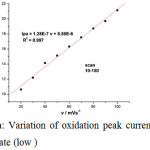 |
Figure 6a: Variation of oxidation peak current with scan rate (low) Click here to View figure |
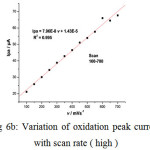 |
Figure 6b: Variation of oxidation peak current with scan rate (high) Click here to View figure |
A linear correlation exists between peak potentials (Ep) and logarithm of scan rates. From the slope of the lines indicate, the number of electron (n) involved in the reaction which is estimated to be two assuming the value of α to be 0.525. Therefore the electro oxidation of DA giving electroactive Dopamine quinone26 is a two electron two proton process at GN-Cu/GCE. There is appreciable increase in the adsorption and rate of electron transfer at the modified electrode compared to bare GCE27. At pH 7, protonation of the amine group occurs and DA forms an acid conjugate which gets strongly adsorbed on the electrode surface. The phenyl structure of DA and two dimensional planar hexagonal carbon structure of graphene enter into pi-pi interaction making electron transfer highly feasible28. The electro oxidation was also accelerated by the copper oxide nanoparticles. Fig.7. represents the DPVs of different concentrations of DA from 0.5µM to 0.1mM in 0.1 M PBS (pH 7), at GN-Cu/GCE. A linear voltammetric response was obsreved and the detection limits as low as 200 nM. The results obtained promise the use of the GN-CuO as an excellent sensor for dopamine.
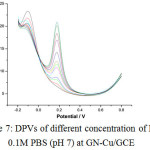 |
Figure 7: DPVs of different concentration of DA in 0.1M PBS (pH 7) at GN-Cu/GCE |
Simultaneous Determination of DA and UA
Uric acid (UA) is an important interferent as the metabolic end product in the human body29,30. Simultaneous determination of DA and UA at GN-Cu modified GCE was investigated using DPV (fig.8). The modified electrode is successful in resolving separate anodic peaks for DA and UA. The GN-Cu/GCE resolve the voltammetric response of DA and UA into well defined peaks at 0.176 and 0.300V respectively indicating that their voltammetric response is independent of each other.
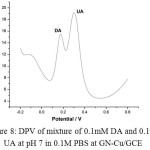 |
Figure 8: DPV of mixture of 0.1mM DA and 0.1mM UA at pH 7 in 0.1M PBS at GN-Cu/GCE |
Role of Scan Rate on Simultaneous Determination of DA and UA
The CVs of mixture of 0.1mM DA and UA in 0.1M PBS (pH 7) at GN-Cu/GCE was recorded at different scan rate range from 10 to100 mV/s (fig.9). Peak currents exhibited linearly with scan rate indicating oxidation process is surface controlled. Appreciable peak current and separation were obtained at a scan rate of 50mV/s and it was optimized for this study. There existed a linear relation between oxidation peak current and scan rate. A correlation of 0.997 (fig.10A) points to adsorption controlled process occurring at the electrode 31. But for UA a diffusion controlled process is taking place as oxidation peak current varies with square root of scan rate (fig.10B)32.
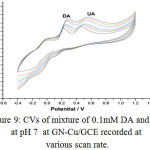 |
Figure 9: CVs of mixture of 0.1mM DA and UA at pH 7 at GN-Cu/GCE recorded at various scan rate. |
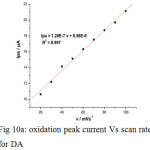 |
Figure 10a: oxidation peak current Vs scan rate for DA Click here to View figure |
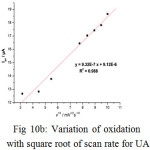 |
Figure 10b: Variation of oxidation with square root of scan rate for UA |
Conclusion
Glassy carbon electrode modified by graphene copper chitosan composite served as an effective sensor for dopamine at physiological pH 7. Evaluation of the influence of scan rate revealed that it was an adsorption controlled process. The redox reaction confirms to a two electron two proton transfer process. The voltametric response was found to be linear for an appreciable range of concentration and reaching a detection limit of 200 nM.
Reference
- Zhao, H.; Zhang, Y.; Yuan, Z. Analyst. 2001, 126, 358-360
CrossRef - Reyes, S.; Fu, Y.; Double, K.L.; Cottam, V.; Thompson, L.H.; Kritik, D.; Paxinos, G.; Watson, C.; Cooper, H.M.; Halliday, G.M.; Neurobiology of Aging. 2013, 34, 873-886.
CrossRef - Manjunatha, H.; Nagaraju, D.H.; Suresh, G.S.; Venkatesha, T.V.; Electroanalysis. 2009, 21, 2198.
CrossRef - Zen, J.M.; Chen, P.J.; Analytical Chemistry. 1997, 69, 5087-5093.
CrossRef - Li, Y.; Lin, X.; Sens. Actuators B. 2006, 115, 134.
CrossRef - Liu, A.; Honma, I.; Zhou, H.; Biosens. Bioelectron. 2007, 23, 74.
CrossRef - Yao, H.; Sun,Y.; Lin, X.; Tang, Y.; Huang, L.; Electrochim. Acta. 2007,52, 6165.
CrossRef - Hu, G. Z.; Zhang, D. P.; Wu, W. L.; Yang, Z. S.; Colloids Surf. B.2008, 62, 199.
CrossRef - Selvaraju, T.; Ramaraj, R.; Electrochem. Commun. 2003, 5, 667.
CrossRef - Westervelt, R. M.; Science .2008,320, 324.
CrossRef - Heli, H.; Jafarian, M.; Mahjani, M.G.; Gobal, F.; Electrochim. Acta. 2004,49, 4999.
CrossRef - Torto, N.; Ruzgas, T.; Gorton, L.; Electroanal, J.; Chem. 1999,464, 252.
- Wu, H.; Cao, W.M.; Li, Y.; Liu, G.; Wen, Y.; Yang, H.F.; Yang, S.P.; Electrochim. Acta. 2010, 55, 3734.
CrossRef - Zhao, J.; Wang, F.; Yu, J.; Hu, S.; Talanta. 2006,70, 449.
CrossRef - El-Khatib, K.M.; Abdel Hameed, R.M.; Biosens. Bioelectron .2011,26, 3542.
CrossRef - Marcano, D.C.; Kosynkin, D.V.; Berlin, J.M.;Sinitskii, A.;Sun, Z.; Slesarev, A.; Alemany, L. B.; Lu, W.; Tour, J.M.; ACS Nano. 2010, 4, 4806-4814.
CrossRef - Eswareiah, V., Aravind ,S. S. J., Ramaprabhu ,S., Mater, J.; Chem. 2011,6800-6803.
- Mott,D.; Galkowski, J.; Wang, L.Y.; Luo, J.; Zhong, C.J,; Langmuir. 2007,23, 5740-5745.
CrossRef - Abd El-Haleem, S.M.; Ateya, B.G.; Electranal, J.; Chem. 1981,117, 309.
- Hassan, H.B.; Abdel Hamid, Z.; Int. J. Electrochem. Sci. 2011,6, 5741-5758.
- Manjunatha, J G.; Kumara Swamy, B E.; Deraman, M.; Mamtha, G P.; Int. J. Pharm.Sci. 2013, 5, 355-361.
- T.E. Mary Nancy, V. Anithakumary, B.E. Kumara Swamy, ournal of Electroanalytical Chemistry, 2014, 702-721, 107-114.
- Peik-See, T.; Pandikumar, A.; Nay-Ming, H.; Hong-Ngee, L.; Sulaiman, Y.; Sensors. 2014, 14, 15227-15243.
CrossRef - Fotouhi, L.; Fatollahzadeh, M.; Heravi, M M,.;Int. J. Electrochem. Sci. 2012, 7, 3919-3928.
- Hongzhe Kang, Yan Jin, Qian Han, Analytical Letters. 2014, 47, 1552–1563.
CrossRef - Farzin, L.; Hosseni, M.R.M.; AJAC. 2011, 2, 289.
CrossRef - Banks, C. E.; Compton, R. G.; Analyst. 2006, 131, 15-21.
CrossRef - Wang, Y.; Li, Y.; Tang, L.; Li, J.; Electrochem. Commun. 2009 ,11, 889-892.
CrossRef - Zen, J.M.; Analyst. 1998 , 123, 1345-1350.
CrossRef - Milland, E.; Ordieres, A.J.M.; Blanco, P.T.; Smyth, M.R.; Fagain, C.O.; Talanta. 1996 , 43, 785-796.
CrossRef - Mary Nancy, T.E.; Anithakumary, V.; Electrochimica Acta. 2014, 133, 233-240.
CrossRef - Ali A.; Ensafi, Taei, M.; Khayamian, T.; Colloids and Surface B: Biointerfaces. 2010, 79, 480-487.

This work is licensed under a Creative Commons Attribution 4.0 International License.









